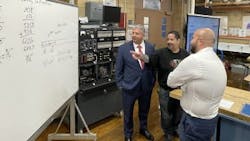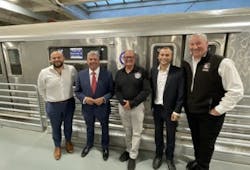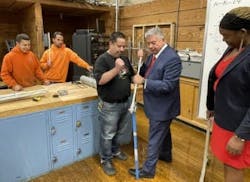Brooklyn D.A. Eric Gonzalez Visits Building Trades Educational Benefit Fund
Brooklyn District Attorney Eric Gonzalez recently visited the Building Trades Educational Benefit Fund to learn more about an apprenticeship training program offering students a viable, hands-on alternative to traditional four-year universities. USWU Local 363 officials, including union President Lou Lolacono, also joined the tour of classroom visits and facility overviews led by Educational Director Paul Iaccarino (Photo 1).
The Building Trades Educational Benefit Fund’s five-year electrician program is funded by Local 363 employers as part of a robust benefits package for their members.
Gonzalez was intrigued by the rigorous, no-cost apprenticeship program that he believed could serve as a model for the future development of similar programs across the region. The program, located at Transit Tech High School in East New York, offers fulfilling career paths leading directly to the hallmarks of middle-class prosperity — quality health benefits, strong wages, pensions, and an avoidance of student debt.
“As District Attorney, I'm keenly aware that public safety is a lot about creating opportunities, including social mobility for young people,” said Gonzalez, who grew up in a nearby neighborhood in East New York. “And so, schools like the Building Trades play an important role in keepingour communities safe.”
Whether they hold a high school diploma or a GED, students can join Local 363’s apprenticeship program, start working, save money for the future, sign up for a generous pension plan, and receive full healthcare benefits from their employers. These benefits, in addition to secure retirement options, extend to their spouses and families. Many of the apprentices go on to start their own businesses, thus creating even more jobs for their communities.
Journeymen electricians typically advance to earn six-figure salaries and help fill a nationwide shortage of electricians as the country looks to transition away from fossil fuels. Employment of electricians is projected to grow 6% annually until 2032, twice the rate of all other occupations, according to the Bureau of Labor Statistics.
They are part of an evolving perception of the skilled trades, which are increasingly viewed by high school students as an appealing career option rather than a last resort.
“Society requires us to have these trained electricians and technicians, and so vocational education is something that I believe the DOE needs to be more thoughtful about to create these spaces,” Gonzalez said.
During the tour, Gonzalez and Lolacono observed a first-year apprentice class working on armored cable wiring tasks at their assigned stations. Antrell Robinson, a first-year apprentice and graduate of Transit Tech HS, explained to Gonzalez and Lolacono how to read basic wiring diagrams and deliver power through switches to receptacles using BX cable (Photo 2).
They also observed third-year apprentices learning how to use measurements and tools to bend pipe and electrical conduit in and around working spaces. Under the guidance of longtime instructor Axel Natal, Gonzalez learned how to use a conduit bender in front of the class (Photo 3).
The guests even checked out the building’s “rail car lab,” where an MTA subway car is stationed behind student projects and workspaces. When students walk through that room, they can see the practical applications of what they're learning.
“The Building Trades Educational Benefit Fund is the kind of program that can propel our economy for years to come,” said USWU Political Director Connor Shaw.
“These students are clearly passionate about working with their hands and motivated by the prospect of a sustainable, fulfilling career that might not otherwise be available through the traditional four-year college route.”
At the end of the tour, Gonzalez recalled his wife Dagmar’s past role as a teacher at an automotive school and noted the positive impacts of education in the skilled trades.
“It kept those students going to school because they were motivated, and they had jobs and they were getting paid while they were in school. They stayed out of trouble,” Gonzalez said. “We have to provide more of these schools. I will be a cheerleader for the Building Trades Educational Benefit Fund."



